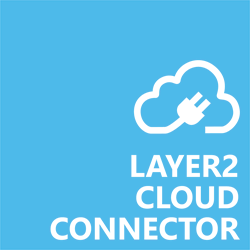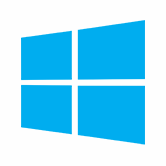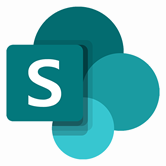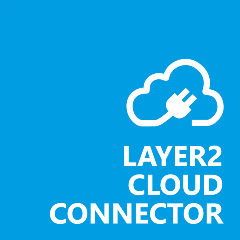Using SharePoint as a File Server - How to connect both systems
This "how-to-connect" tutorial will explain the configuration of an example connection from File Server to a SharePoint Online Document Library in Office 365. We will synchronize data stored in File Server. With this connection you will be able using SharePoint as a file server - or like a file server. After our tutorial you will learn more about the advantages of SharePoint and a connection to your file server.
We recommend you to try Layer2 Cloud Connector for free. If you want to learn more about basic functionalities please take a look at our Layer2 Cloud Connector User Documentation.
Using SharePoint as a file server: step-by-step connection instructions
You learn how to configure your File Server and how to configure Layer2 Cloud Connector. We provide you with practical hints and known issues for a smooth start.
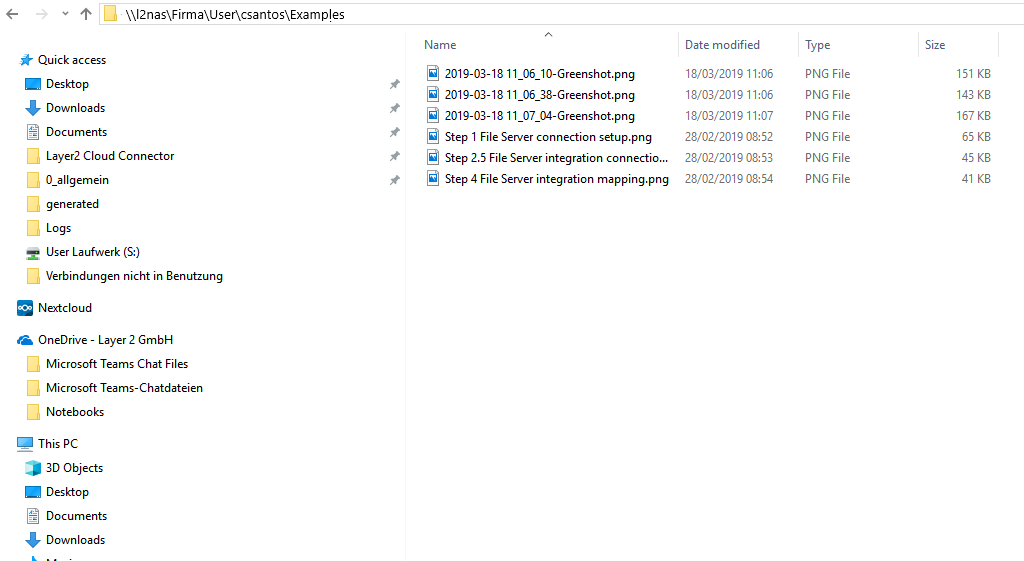
Step 1 - Configure your File Server
You are only going to need the path to the local folder from your server where the files you want to synchronize are in. In our case a NAS server.
Step 2 - configure a new connection in Layer2 Cloud Connector
Create a new connection by using the Create New Connection option in the Actions pane (right-hand side). The new connection will appear at the bottom of the Connection Manager List (left-hand side). Click on your newly created connection to open the connection configuration settings.
Choose a meaningful name for your connection and replace the current title "New Connection" with it. Connections to File Server can be bi-directional. An initial connection should be uni-directional to assure that both data entities are identical before switching to bi-directional. Therefore, choose Left to Right as Direction. You can change this setting after your initial synchronization finished successfully.
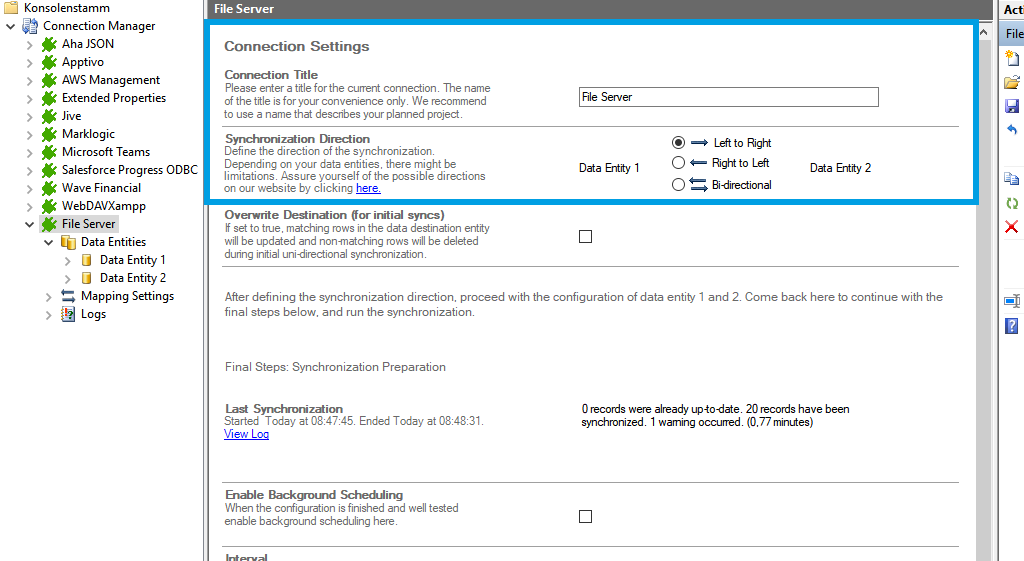
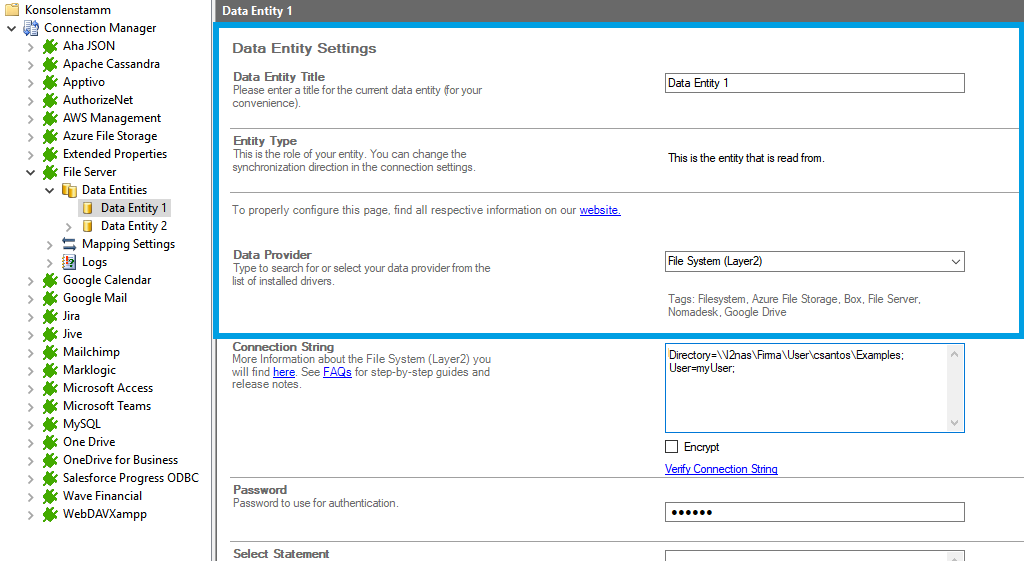
Step 3 - configure the Data Entity 1
We will now set up our Data Entities. Go to the data entity “Data Entity 1” to open the configuration settings.
Choose a Data Entity Title. It is recommended to give your entities meaningful names to maintain an overview when you decide to set up multiple connections.
Select the Data Provider for File System from the data provider list. You can search for File System by typing into the selection box.
For the Connection String, we need the in step 1 mentioned information. You can copy the connection string and adjust it to match your gathered information. Use the Verify Connection String option to evaluate if the provided connection string is valid.
- "Directory=path;" this property defines the folder where the files are in you want to synchronize.
- "User=myUser;" this property defines an account that has access to the share.
Enter the user's password in the password field below the connection string.
Directory=\\l2nas\Firma\User\csantos\Examples;User=myUser;
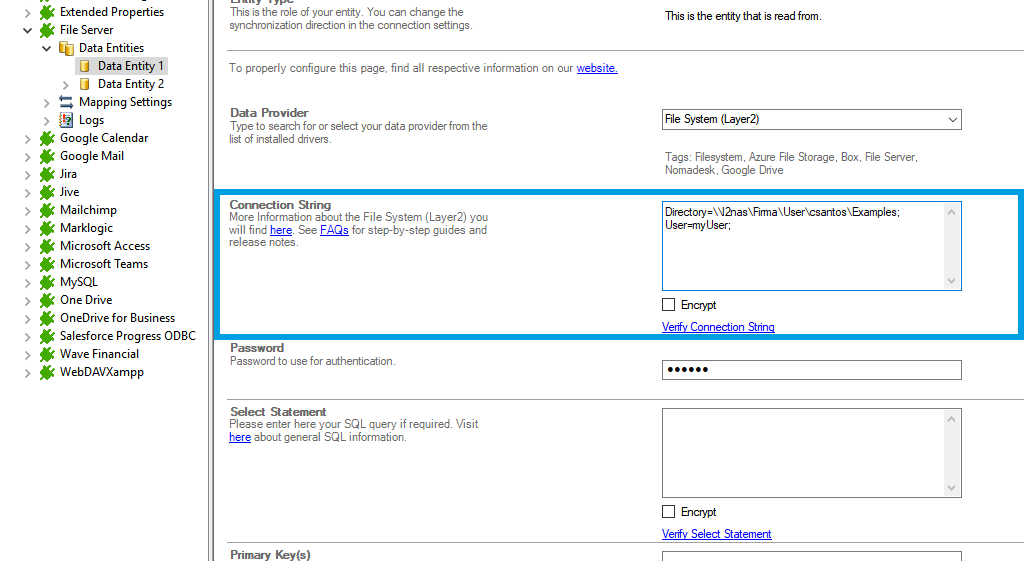
The Select Statement text box is used to define specific data queries, e.g you can filter for specific filetypes. We do not need it in this case.
Save your changes by using the right-hand pane option Save Changes.
To check if all necessary columns are received, you can use the Preview Data option on the right-hand pane which will provide you with a pop-up window showing your sample data from your File Server entity.
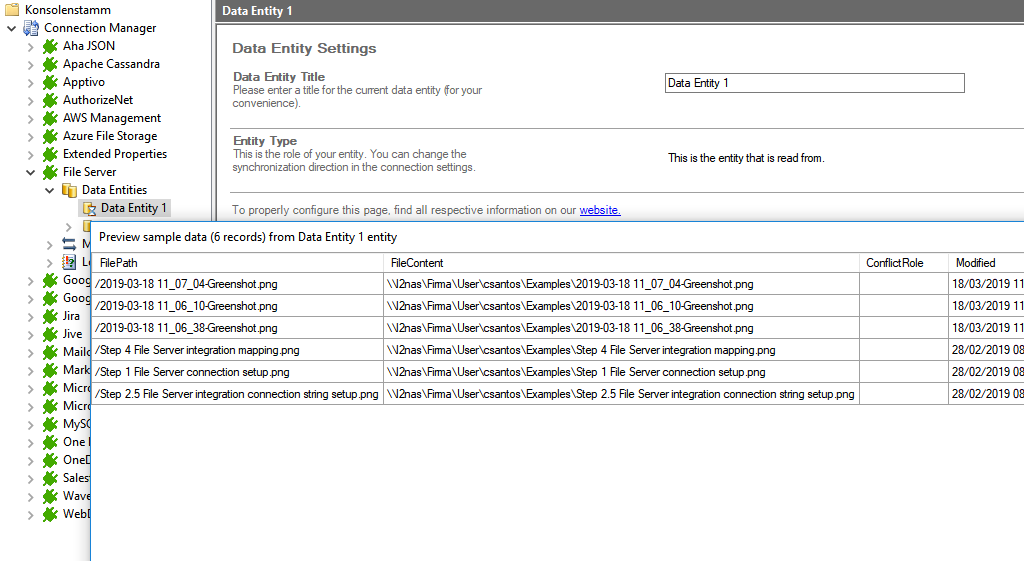
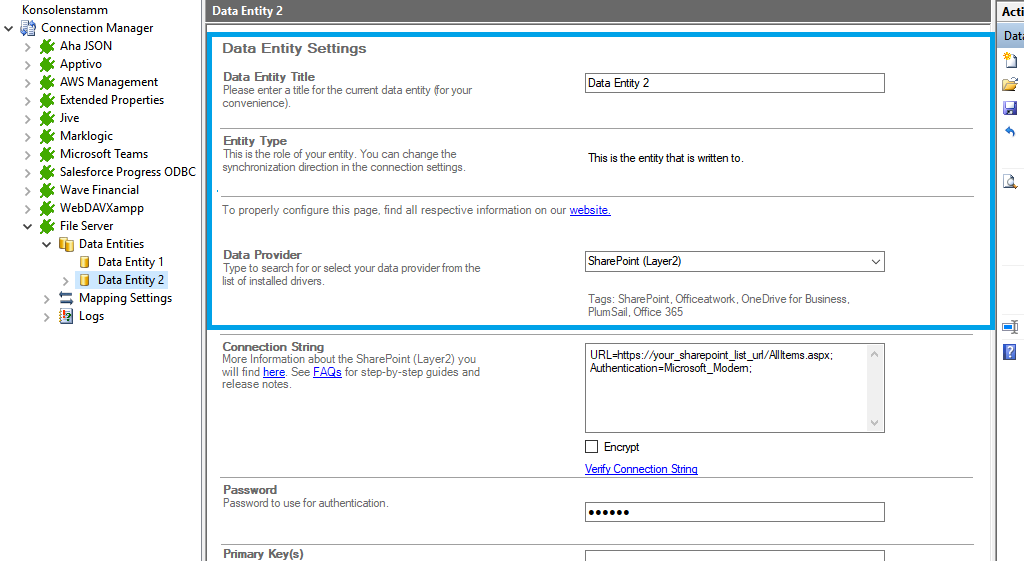
Step 4 - Configure the Data Entity 2
We are going to send the data to a custom SharePoint Online Document Libary. It's required that you set up this library prior to the next steps. Your library should contain matching columns according to your source entity.
Use the left-hand pane to switch to the data entity "Data Entity 2". We will be using the Layer2 SharePoint Provider for this setup.
For more information about the SharePoint provider visit: https://www.layer2solutions.com/support/cloud-connector-faqs/layer2-csom-sharepoint-ado-net-provider.
You can copy the Connection String which contains the minimum of required properties to connect to your custom SharePoint Online Document Library.
URL=https://your_custom_sharepoint_library_url/Forms/AllItems.aspx;Authentication=Microsoft_Modern;
- "URL=https://your_custom_sharepoint_url/Forms/AllItems.aspx;" this property defines the URL of your custom document library that will be addressed.
- "Authentication=Microsoft_Modern;" this property will determine the authentication method used. Microsoft_Moddern is the default authentication method to access Microsoft Office 365 / SharePoint Online and should work in most cases, even if the SharePoint site is connected to an ADFS. This authentication does not need any further connection string settings, other than the URL of the connected system.
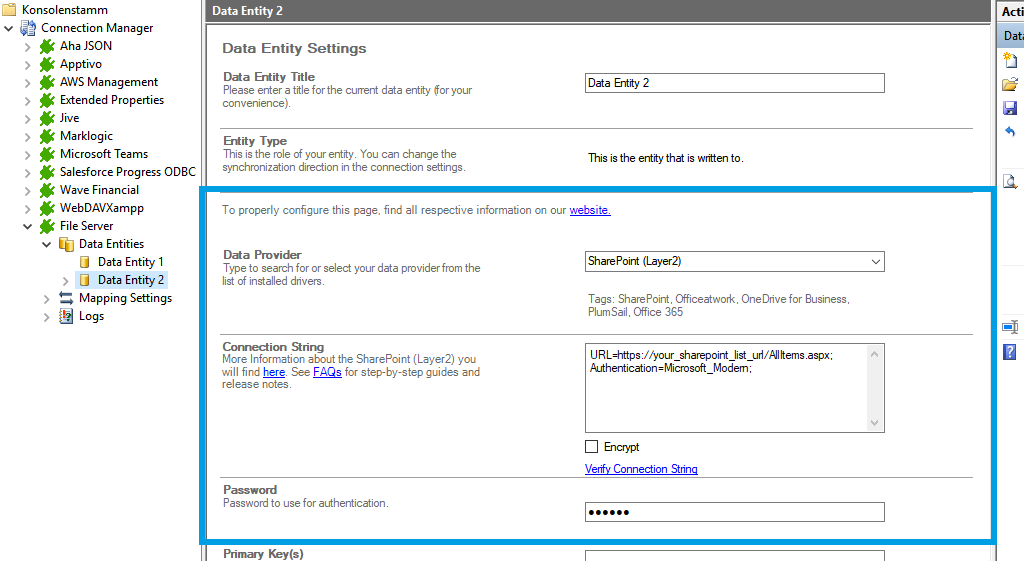
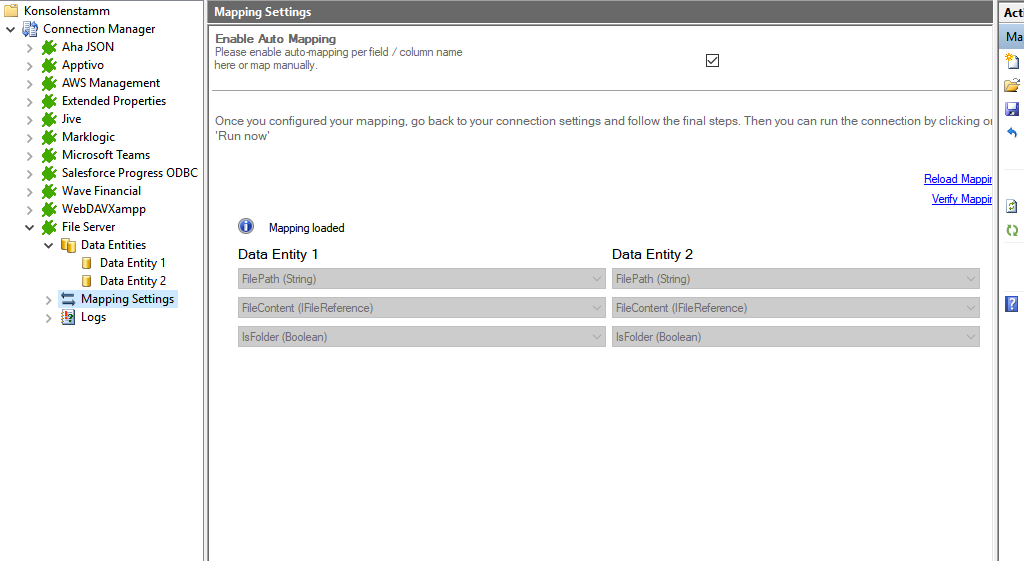
In the next step, we will configure our mapping settings. Click on the Mappings option on the left-hand pane. If your fields from SharePoint are named identical to the fields from your source system, the Enable Auto Mapping option will match those columns.
Disabling this option allows you to match your columns as needed. We enabled auto-mapping in our setup. Save your changes by using the right-hand pane option Save Changes.
Step 5 - running your connection
To run your connection switch back to the main connection configuration node and use the Run Now Button located on the bottom of the setup page. The Run Synchronization Toolbox will also display the synchronization process.
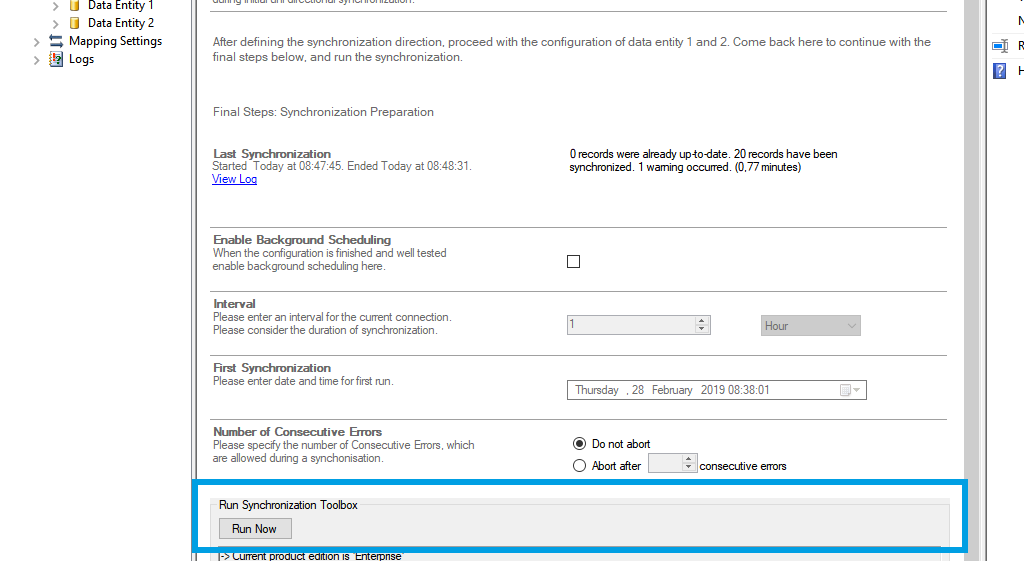
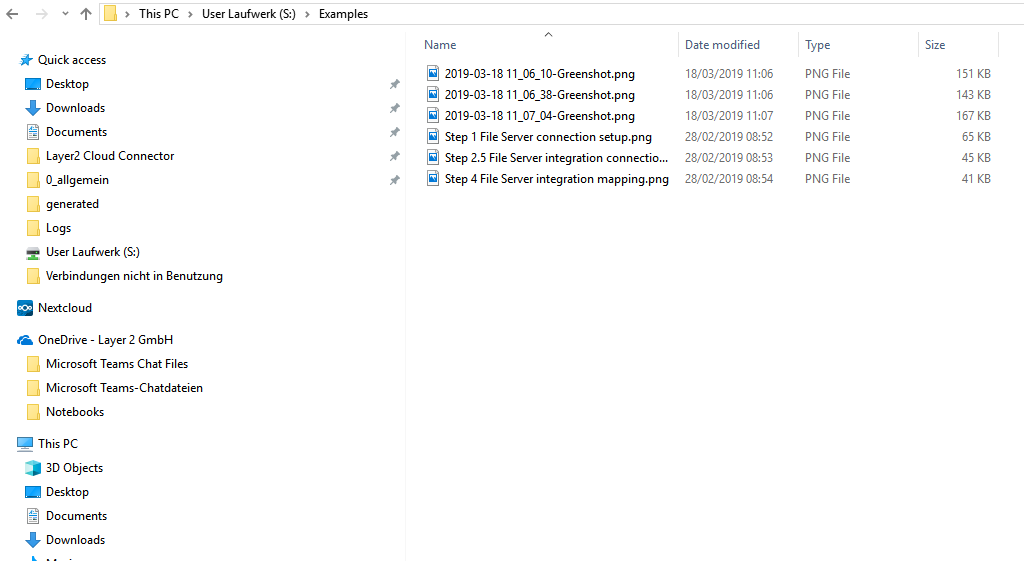
Here is a data preview of the information we have accessed in our source entity.
This will be the result in our SharePoint Online library after our initial successful synchronization.
If you want to use a bi-directional syncronization, you can now switch your connection directon after our first initial synchronization run finished successfully. After adjusting the direction, you should check your Mappings settings again because some systems might include read-only columns that cannot be mapped directly.
We also recommend to choose a Conflict Resolution that matches your enviroments needs. You can find out more about the different conflict resolutions in our Layer2 Cloud Connector User Documentation.

Hints and known issues about using SharePoint as a file server
Connection direction
As far as tested, this connection supports uni-directional as well as bi-directional synchronizations.
Bandwidth
Take care about bandwidth limitations and Office 365 throttling, especially for the first sync. Estimations are displayed if using the toolbox for first sync. Estimations can change during the sync process, stay patient. You can stop and restart the sync whenever you want.
Limit of files
While there is no hard limit for the amount of files to sync, keep the number of documents per library (connection) as low as possible. To keep 100.000 documents in sync should not be problem, a powerful configuration can do much more. But consider the SharePoint / OneDrive limitations, and your Office 365 plan.
SharePoint list view threshold
Note about the SharePoint list view threshold (above 5.000 / 20.000 documents per library). This is not an issue for the sync - but could be an issue for some SharePoint features and apps. Users will still be able to page through a library, use search to find specific files. There can be issues with using specific views, filters, grouping etc. See Microsoft documentation for more details.
UNC notation
If you are using a source path similar to H:\myPath and got a "not found" error, please make use of UNC notation, such as \\myServer\myPath.
Domain account
Note that the sync is processed by the Layer2 Windows Service. If it runs under a local service account, it will not have access to shared drives. You can run under a domain account to fix this issue. In this case you don't need to give access data in the connection string.
Tips for settings in SharePoint that help you structuring your files and folders
Plan your library and folder structure
Take some time to plan structure and names of your libraries and folders. Organize files into meaningful libraries, for example by department or workgroup. Define clear naming conventions.
Use metadata
Metadata, such as tags, properties, or custom columns, allows for flexible categorization and filtering of content. Encourage users to tag documents with relevant metadata to enhance searchability.
Use Permissions Wisely
Apply permissions at the appropriate level to control access to sensitive information. Avoid breaking permission inheritance excessively, as it can lead to management challenges. To secure sensitive information, consider creating seperate libraries that only specific groups or users get permissions for. Limit access rights according to roles and responsibilities.
Avoid Nested Folder Structures
Deeply nested folder structures can make it challenging for users to find documents. Instead, use metadata, views, and search functionalities to categorize and retrieve files.
Advantages of using SharePoint for your business
- High security thanks to user authentication, encryption and access permissions your data is safe.
- You can collaborate with your colleauges or partners on the same document. Even multiple team members can add changes - at the same time.
- SharePoint offers version control and restores previous versions of your documents.
- Remote access through the web interface or your mobile app you can access documents and data from everywhere and at any time.
- Because of the scalability large volumes of data don't affect the performance.
Benefits of using SharePoint as a file server - or more precisely a connection of the systems
Central access
Utilizing SharePoint as a file server offers the benefit of central access, enabling users to conveniently retrieve and manage files from a single location.
Easy to setup
Setting up SharePoint is straightforward, with user-friendly tools and interfaces, making it easy to deploy and configure according to your organization's needs. With Layer2 Cloud Connector you can connect it with your file server in minutes.
Work more efficient
Teams can collaborate more efficiently on documents, projects, and tasks, leveraging features like version control and real-time co-authoring to streamline workflows. No matter which of both systems they use.
Integrate and sync data between your systems
Your data is always up to date - in SharePoint and your file server. Seamless connectivity and enhancing data consistency across your platforms prevents errors and
Integration and synchronization of SharePoint and File Server
Start your Layer2 Cloud Connector trial and experience how easy it can be to connect File Server to SharePoint. It's time to take the first step towards effortless connectivity. Using SharePoint as a file server is possible with Layer2 Cloud Connector.
Frequently asked questions about SharePoint and file servers
Here we will answer several questions about SharePoint and a file server.
What is a file server?
A file server is a computer or storage device on a network that stores files accessible to users and other devices within the network. It is a centralized location for storing and sharing documents, media, and other data.
What is SharePoint Online?
SharePoint Online is a cloud-based collaboration platform developed by Microsoft and part of Office 365 suite. It offers features for document management, team collaboration, content sharing, and workflow automation - accessible through a web browser.
Why is SharePoint itself not a file server?
SharePoint itself is not a file server because a file server primarily provides storage and access to files within a network. SharePoint offers additional features such as version control, metadata management, workflow automation, and integration with other Microsoft 365 applications. SharePoint is a collaboration platform designed to enhance teamwork and productivity.
How can I use SharePoint as a file server?
You can use SharePoint as a file server or like a file server when you connect both systems with Layer2 Cloud Connector.
Can SharePoint replace a file server?
SharePoint can not replace a file server due to limitations in handling certain types of files, such as large media files or specialized file formats. Additionally, organizations with specific compliance requirements can't transition entirely to SharePoint for their file storage needs.
Using SharePoint like a file server with Layer2 CLoud Connector
Unlock your full potential and integrate your SharePoint and file server data for seemless collaboration. With our free trial edition you can test your use case now.

